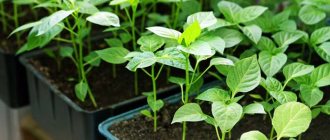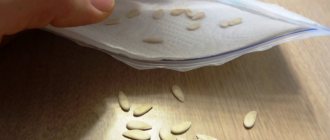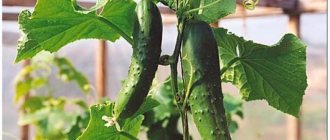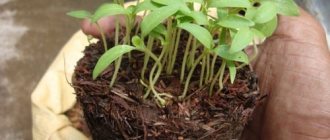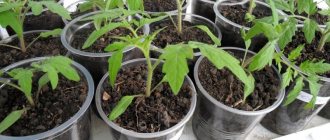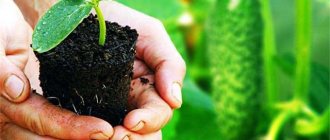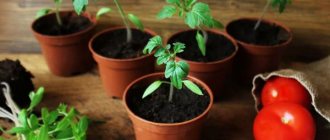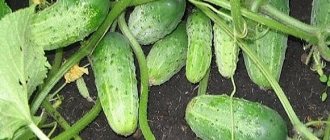How impatiently we wait for the first cucumbers - crunchy, sweet, with delicate skin... To get the harvest a few weeks earlier, you can grow cucumbers using seedlings. We will tell you in detail how to grow cucumber seedlings and transplant them into the garden.
Cucumbers are sown 20-25 days before the expected date of transplanting the plants into the ground. This date depends on the region and conditions for growing cucumbers. Seedlings can be planted in open ground when warm weather sets in and the soil warms up to 16-18°C. In central Russia this is the first ten days of May. This means that you can sow cucumbers for open ground seedlings closer to mid-April. And for a greenhouse - a few weeks earlier.
Features of growing cucumber seedlings
A trick that allows you to grow and safely move cucumber seedlings to the garden bed is to grow them in separate containers. However, this method is not suitable for everyone due to a number of reasons.
- Firstly, there is not always free space to place individual glasses with cucumber seedlings. This forces summer residents to sow cucumber seedlings in one container.
- Secondly, in a situation where seedlings do not have enough light, they inevitably stretch out. The result is plants with weak stems. Timely transplanting into another container with deepening of the seedlings will help correct the situation.
- The third reason for picking cucumber seedlings is the belief of some gardeners that this is a mandatory operation to strengthen the root system of plants.
The third statement is partly true, but provided that all manipulations for transplanting seedlings into a larger container are performed correctly.
Mandatory conditions for obtaining healthy cucumber seedlings include:
- quality seeds;
- loose and nutritious soil mixture;
- full lighting;
- reasonable watering;
- properly selected temperature conditions.
Cucumber seedlings develop very quickly, but do not stretch with high-quality lighting, regular ventilation and reasonable watering. Plants should not be over-watered, as this will lead to root diseases. And the lack of light causes plants to stretch out, which ultimately leads to too long and weak stems.
Regular ventilation will help avoid moisture stagnation and even out the temperature. Proper picking will allow you to obtain high-quality planting material that can produce a bountiful and early harvest.
Soil for cucumbers on the windowsill
Just like the soil for growing seedlings, the soil for transshipment of cucumbers should be loose, light, porous, and the acidity of the soil should be close to neutral. Increased acidity will negatively affect the growth of homemade cucumber due to a decrease in the availability of some macro- and microelements and, on the contrary, an increase in the toxicity of elements such as manganese, aluminum, iron, boron. Another important requirement is that the soil must be clean and free of pathogenic microbes.
Soil mixture for seedlings
But the soil for transshipment should be different from the soil of the first stage of growing seedlings. The soil mixture for the subsequent growth of cucumbers is more nutritious - it contains all the necessary nutrients for the growth and development of the plant and microelements in the required proportions, because an excess of one or another substance is just as harmful as a deficiency.
To ensure that the soil meets all the requirements, we will make a soil mixture. First, let's look at its components and remember the composition of the mixture that was used for sowing seeds.
Many gardeners steam and fry the soil to kill all harmful microorganisms. This, of course, disinfects the earth, but not only harmful microbes die, but everything. However, beneficial bacteria process excess fertilizer, protecting plant cells. Beneficial microorganisms cover the roots and have fungicidal and bactericidal effects. Such bacteria are indispensable for plant growth and health. In our case, steaming of the garden soil was not carried out.
The composition of the previously compiled soil mixture (remember)
- Garden soil taken from the place where marigolds grew, having a fibrous root system. Tagetes enrich the composition of the soil, and the small roots remaining in the soil increase microcirculation of oxygen and protect plants from fungal infections.
Marigolds as green manure
Additional components
- To ensure additional looseness of the soil mixture, we take a coconut substrate, which we first soak in water and rinse under a running stream. Add one coconut briquette to 10 liters of soil.
- To cleanse the soil mixture and saturate it with useful substances, add mustard cake (1/9 of the volume of soil). Mustard prevents fungal diseases, as well as putrefactive and bacterial infections.
- And one more component - diatomite (1/10 of the volume of earth). Dolomite flour contains calcium and magnesium. Calcium carbonate is aimed at normalizing pH. Magnesium is necessary for the development of plants and prevents infection with fungal diseases.
Soil improver diatomite
- Three days before sowing the cucumber seeds, the soil mixture was spilled with a phytosporin solution.
To transship cucumber seedlings, we enrich the soil mixture with the following nutritional components:
- Add organomineral fertilizer OMU Rost, intended for seedlings, to the prepared soil. To do this, mix 5 kg of soil with one fifty-gram bag. This fertilizer contains macro- and microelements in the proportions required for small plants.
- We use another component for preparing substrates - organic fertilizer vermicompost, which saturates the soil with beneficial microorganisms.
Nutrient additives to the soil
It is also good to add about half a liter of wood ash to 10 liters of soil, which will be both a fertilizer and a soil deoxidizer.
Timing for picking cucumbers
Experienced gardeners know that seedlings of cucumbers, zucchini, pumpkins and watermelons develop very quickly. A competent approach to the question of how to properly pick cucumbers requires strict adherence to the timing of this procedure.
Timely transplantation of cucumber seedlings will save the plants from painful and lengthy adaptation to a new container or garden bed, since the root system will not be injured.
The optimal period for transplanting cucumber seedlings should be determined by the appearance of the seedlings. The work should be done at the moment when the cotyledon leaves are fully expanded. Picking is also allowed in the phase of a pair of true leaves.
It should be understood that at the next stage of development, cucumber seedlings will survive the transplant operation worse. It is important to know that you should not delay picking due to the active development of plants.
Germination and harvest dates
You can grow cucumbers at home by a certain date. If it is necessary for the harvest to ripen by the new year, sowing is carried out in early October. When calculating deadlines, the following rule must be used:
- 1-3 days for soaking and biting;
- 3-4 days for germination after sowing;
- 40-50 days before harvest.
Depending on the use of fertilizers and growing conditions, these periods may shift slightly up or down. Cucumbers do not have a dormant period; they bear fruit almost continuously. But at a certain point they will reach their peak yield, after which their productivity will decline.
Selection of containers for picking
Before picking cucumbers, you need to take care of containers for plants in advance. For this purpose, it is wise to use peat or plastic glasses with a diameter of at least 10 cm.
It is important to ensure that the container for cucumber seedlings has drainage holes to remove excess moisture. When using food containers, you should cut the holes yourself. They are easy to make in plastic cups using an old screwdriver heated over an open fire.
Containers for cucumber seedlings must be clean, so it is recommended to wash them with a weak solution of potassium permanganate.
In what containers and when to plant balcony cucumbers
Cucumbers are often grown in adapted containers:
- in old unnecessary pots;
- in cut 5-liter bottles;
- in pots, buckets;
- in plastic paint cans;
- in plastic and wooden boxes.
The main thing is that a layer of soil of 7-8 cm and a layer of drainage remain below the roots. Holes must be made at the bottom of the container, because excess water is detrimental to the plant.
If the balcony is insulated, the seeds are sown in January, on the 15th-17th, and the first harvest is harvested in April. If not, then they calculate the time for transplanting into permanent containers, taking into account that the seedlings grow in 30-40 days.
Preparing soil for cucumbers
Cucumbers require loose and nutritious soil at all stages of plant development. For picking cucumber seedlings, universal purchased soil containing peat is suitable.
It is easy to prepare the soil mixture yourself. To do this you need to mix:
- turf land;
- high peat;
- humus;
- wood sawdust.
The components for preparing the soil mixture are used in equal proportions. The soil must be disinfected by calcining it in the oven or spilling it with a weak solution of potassium permanganate. After treatment with potassium permanganate, it is recommended to start picking after three days.
Transplanting cucumbers on a windowsill into a bag using the transshipment method
We plant one plant in each 10 liter bag. We tuck the upper edges of the bag: as the cucumber grows, you can unfold the edges of the bag and add soil. At the first stage, the plant will develop the lump of earth that was originally in the bag. As soil is added, the cucumber vine will acquire additional roots, which will lead to its rejuvenation, rapid growth and development. It is impossible to tuck the edges in a regular pot or bucket, and if we fill half the pot with soil, the walls of the container will shade the plant.
The procedure for picking cucumber seedlings
The work of picking cucumbers is not very difficult, since the gardener is dealing with fairly large seedlings. Detailed instructions will help inexperienced gardeners cope with the task.
- First of all, you need to fill the containers with nutrient soil. They should not be packed too tightly so that air can freely penetrate to the roots.
- The soil in the glasses is poured with plenty of water. This gives the necessary shrinkage and also provides the seedling with sufficient moisture.
- It is necessary to make sufficiently deep funnel holes in the prepared containers with soil.
- Cucumber seedlings intended for transplantation are removed from a common box one at a time. In this case, you should not grasp the stem of the plant with your fingers. The seedling is removed along with a clod of earth. For picking, it is convenient to use small disposable plastic spoons.
- The seedling is placed in the prepared funnel hole so as to deepen the stem as much as possible. This is especially important if you have to deal with elongated seedlings.
- The seedlings are buried so that the cotyledon leaves do not touch the soil. The soil in the container is carefully moved, adding to the plant. But they don’t compact it!
- After picking, water the cucumber seedlings.
It is useful to know that for cucumber seedlings that are too elongated, it is wise to use high containers that allow the seedlings to be buried as deep as possible. This technique will allow you to obtain healthy and strong planting material.
How to pick cucumbers
First of all, you need to clearly determine the timing of the picking work. Cucumber seeds germinate quite quickly. Full-fledged cotyledon leaves are formed within 7 days after sowing. Experienced gardeners prefer to plant cucumbers in cups during this period.
Preparing for a pick
Prepare containers for transplantation in advance. You can use disposable glasses with a volume of 0.5 liters; peat pots of the same volume are suitable. You can use milk cartons to grow seedlings. Make a drainage hole in the cups at a distance of 1 cm from the bottom. You can put an eggshell or a piece of dried banana skin on the bottom.
Picking into open ground
The question of how to plant cucumbers in open ground deserves special attention. Here, important attention should be paid to the timing of this operation.
It is advisable to plant cucumber seedlings in open ground when not only the air, but also the soil has warmed up sufficiently. Planting cucumber seedlings in cold soil entails the development of root diseases, a delay in plant development, and sometimes their death.
Therefore, it is recommended to transplant cucumbers into the garden when there is no longer a danger of night and morning frosts, and the soil has warmed up sufficiently.
To pick, you need to loosen and water the soil and make planting holes in it. It’s a good idea to sprinkle some high-moor peat into the holes. It will make the soil more loose and breathable, which is important for cucumbers.
The picking is carried out carefully, the plants are moved with a lump of earth. After picking, water thoroughly.
Rules of care
Inexperienced vegetable growers often wonder: how to grow cucumbers in an apartment during short winter days? The answer is quite simple. To do this, you will need to create a certain light mode.
Light
Cucumbers should be placed on window sills, on windows facing south or southeast. They are very demanding on the level of illumination. For full development, they need at least 15-16 hours of daylight. That is why growing cucumbers in winter is impossible without organizing lighting.
To arrange additional lighting you can use:
- fluorescent lamps;
- special phyto lamps.
They are placed at a height of 20 cm above the tops of the plants. The lamps may have to be raised several times, as cucumbers grow quickly.
Advice! For a more rational distribution of light, the cucumber lashes must be hung using thin twine.
Watering
Cucumbers are moisture-loving plants. They should be watered regularly and quite abundantly. Also, cucumbers in an apartment require constant spraying.
Preparation of irrigation water:
- for spraying you can use ordinary water at room temperature;
- watering must be carried out with warm, settled water;
- you can use melted snow;
- It is unacceptable to use tap water. It contains a large number of different compounds of iron, chlorine and magnesium. Their gradual accumulation in the soil will lead to a decrease in yield and death of plants.
Top dressing
Growing cucumbers in winter is impossible at home without the use of fertilizers. They are applied once every 10 days. For these purposes, you can use any mineral complexes. Fertilizers should be diluted in strict accordance with the attached instructions. You can also use humate enriched with microelements. Supporters of organic farming would probably like to know how to grow cucumbers in winter without using chemicals.
For connoisseurs of environmental solutions, fertilizing with an infusion of orange peels is suitable. Stages of preparing the tincture:
- crush a handful of orange peels;
- pour boiling water over the resulting raw material;
- leave the mixture for 3-5 days;
- the appearance of bubbles indicates the readiness of the fertilizer;
- Before use, the infusion of orange peels is diluted with water in a ratio of 1:3.
Pinching and gartering
Cucumbers in an apartment require timely formation. To do this, after the 5th leaf appears, the central shoot is pinched with it. On the resulting side shoots, the crowns are removed in the same way. Scourges that have been pinched must be tied up immediately. This will make caring for the plant much easier and prevent shoots from breaking off.
Pollination
Some varieties of cucumbers require hand pollination when grown at home. Its essence is the transfer of pollen from male flowers to female ones. In natural conditions, pollinating insects do this, but in winter, in an apartment, you will have to do pollination yourself.
Pollination begins a day after the flowers open. To do this, prepare a small brush or cotton swab. Pollination is best carried out at a temperature of 24-26°. It is recommended to pre-humidify the air around the plants by spraying from a spray bottle.
Attention! When pollinating, it is important to distinguish male flowers from female ones. This can be done based on them. Female flowers have a small cucumber at the base.
Pollination can be carried out with a brush with soft bristles or a cotton swab. To do this, pollen is collected from the male flower. Then the brush is carefully passed along the pistil of the female flower.
Cucumbers can also be pollinated directly by the male flower in winter. To do this, it is carefully torn off from the stem and brought to the female inflorescence. Its anthers and stamens should be in close contact with the female flower. The male inflorescence can even be left directly in the female flower.
Successful pollination can be determined within 2-3 days. If successful, the ovary begins to quickly increase in size.
Caring for cucumbers after picking
A few simple rules will help cucumbers cope more easily.
- The optimum air temperature is maintained between 18 and 20 degrees.
- Watering is carried out as the top layer of soil dries.
- Seedlings are protected from drafts, but at the same time ventilated a little to avoid rot from overwatering.
A competent approach to growing and picking cucumber seedlings will allow you to obtain healthy planting material and ensure a plentiful and early harvest of cucumbers.
Preparing the soil for replanting
Before planting, the soil must be dug up and fertilized with compost or humus. This will improve the soil structure and enrich it with nutrients. Using ash or chalk, you can regulate the acidity of the soil. Fertilizers that are perfect for growing cucumbers are: urea, superphosphate, and potassium nitrate.
It is recommended to water the garden bed well before replanting. It is better to add a biological product, for example, Baikal M1. Due to this, the process of reproduction of microorganisms will accelerate. It is also advisable to spill the soil with a solution of Fitosporin.
